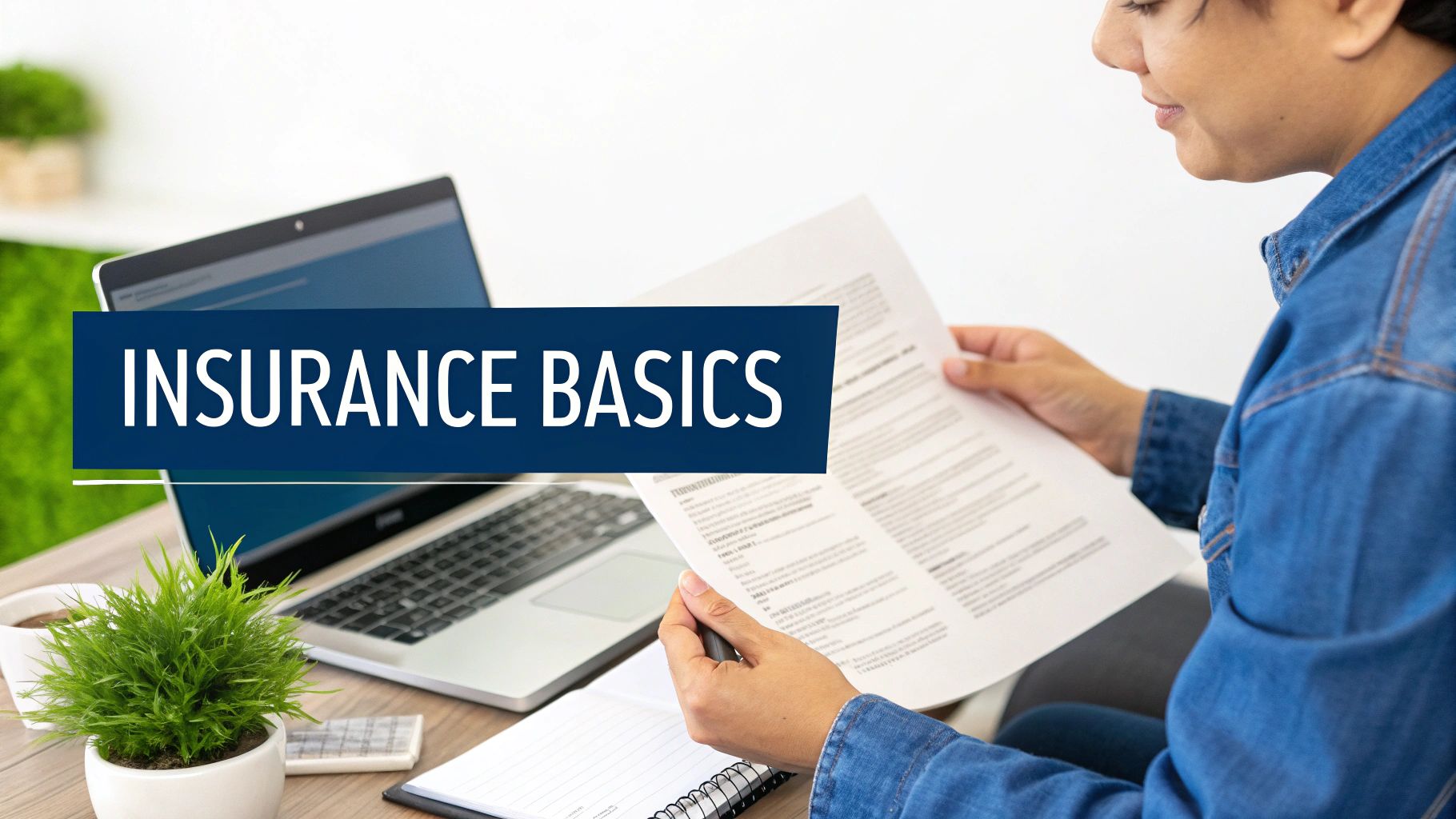How Much Disability Insurance Do I Need? Expert Guide
- dustinjohnson5
- Apr 16
- 14 min read
Why Your Income Needs Protection: The Disability Insurance Reality

Your ability to earn a living is your greatest asset. It provides financial security, allowing you to meet current needs and plan for the future. But what if an unexpected illness or injury prevents you from working? This is where disability insurance plays a vital role.
The Risk is Real: Disability Statistics
Many underestimate the chances of becoming disabled. The truth is, disabilities can affect anyone, regardless of age, occupation, or health. A startling one in four 20-year-olds today will experience a disability before retirement. This highlights the importance of understanding your disability insurance needs, especially early in your career. Knowing how much coverage you need is crucial, given the significant coverage gap that exists.
A 2024 study by LIMRA and Life Happens found that while 46% of U.S. adults recognize they need disability insurance, only 18% have it. This gap shows the disconnect between perceived need and actual coverage. The study also reveals a lack of knowledge about disability insurance, with only 16% of adults feeling well-informed.
Bridging the Gap: Why Standard Solutions Fall Short
Many rely on employer-provided benefits, savings, or government programs for disability protection. These often offer insufficient coverage. Employer-sponsored disability insurance may replace only a portion of your income and may not cover every type of disability. Savings can quickly disappear during an extended disability. Government programs, like Social Security Disability Insurance (SSDI), have strict eligibility requirements and may not provide enough to maintain your lifestyle.
Protecting Your Future: The Importance of Adequate Coverage
Financial advisors stress the importance of disability insurance as part of a solid financial plan. Adequate coverage replaces a significant portion of lost income, allowing you to:
Cover essential living expenses: This includes mortgage/rent, utilities, food, and transportation.
Maintain your current lifestyle: You can continue saving for retirement, education, and other goals.
Protect your family's financial security: Avoid depleting savings or accumulating debt.
Not having enough disability insurance can have devastating consequences, leading to financial hardship, impacting your ability to meet basic needs, maintain your quality of life, and achieve long-term financial goals. Carefully evaluate your circumstances and secure the right amount of coverage to protect your financial future.
The Coverage Formula: Calculating Your Exact Insurance Needs

Finding the right amount of disability insurance is a personal journey, not a one-size-fits-all solution. It requires a tailored approach, going beyond the typical 60-70% income replacement advice. Instead, it necessitates a deep dive into your individual financial landscape. This section offers a clear, step-by-step guide to determining your specific coverage needs.
Identifying Your Essential Expenses
The first step is to pinpoint your essential monthly expenses. These are the non-negotiable costs you must cover, regardless of your working status.
These essential expenses typically include:
Housing: Mortgage or rent payments.
Utilities: Electricity, water, gas, and internet services.
Food: Groceries and necessary household items.
Transportation: Car payments, insurance, fuel costs, or public transportation expenses.
Debt Payments: Minimum payments due on credit cards and loans.
Childcare: Essential daycare or after-school program costs.
For instance, a single person's essential expenses will likely differ significantly from those of a family with children.
Factoring in Future Obligations and Existing Resources
Beyond current expenses, consider future financial obligations that would continue even if you were disabled.
These obligations might include:
Saving for Retirement: Maintaining regular contributions to secure your long-term financial well-being.
College Savings: Continuing to save for your children's education.
Debt Repayment: Making progress toward becoming debt-free, even while disabled.
It's also important to account for existing resources that could offset potential income loss.
These resources could include:
Savings: An emergency fund can offer a temporary financial cushion.
Spouse's Income: A dual-income household might have more financial flexibility.
Employer-Provided Benefits: Clearly understand the percentage of income covered by your employer's disability plan.
Government Programs: Research potential eligibility for government programs like Social Security Disability Insurance (SSDI). Keep in mind, however, that these programs often have strict requirements and might not fully cover your needs.
This thorough assessment helps you accurately calculate your true coverage gap – the difference between your essential expenses and your available resources during a disability.
Calculating Your Ideal Benefit Amount
Once you’ve identified your essential expenses, future obligations, and existing resources, you can determine the ideal disability insurance benefit amount. This is the amount that closes your coverage gap and maintains your financial stability.
Here's an example: Suppose your essential monthly expenses are $4,000, and your existing resources during a disability total $1,500. Your coverage gap is $2,500. Therefore, you need a disability insurance policy with a monthly benefit of at least $2,500 to maintain your current standard of living.
The key is finding the right balance between comprehensive protection and premiums you can afford. America First Financial specializes in providing customized plans for conservative American families and individuals nearing retirement. They can be a valuable resource in your search for affordable disability insurance.
By taking this personalized approach, you move beyond generalized recommendations and determine the precise disability insurance coverage you need. This ensures your financial well-being, regardless of unforeseen circumstances.
To further assist you in calculating your optimal disability insurance needs, consider the following table:
Your Personalized Disability Insurance Calculator This table helps readers calculate their optimal disability insurance coverage based on their specific financial situation.
Income/Expense Category | Monthly Amount | Annual Amount | Notes |
|---|---|---|---|
Housing (Mortgage/Rent) | $1,500 | $18,000 | Includes property taxes and homeowner's insurance (if applicable) |
Utilities | $300 | $3,600 | Includes electricity, water, gas, and internet |
Food | $500 | $6,000 | Groceries and household supplies |
Transportation | $400 | $4,800 | Car payment, insurance, gas, and maintenance |
Debt Payments | $300 | $3,600 | Minimum payments on student loans and credit cards |
Childcare | $500 | $6,000 | Daycare expenses for two children |
Retirement Savings | $250 | $3,000 | Maintaining current contributions |
College Savings | $250 | $3,000 | Continuing contributions for children's education |
Total Essential Expenses & Savings | $4,000 | $48,000 | |
Existing Resources (Spouse's Income) | $1,500 | $18,000 | |
Coverage Gap | $2,500 | $30,000 | This is the amount disability insurance needs to cover |
This table outlines a sample budget and highlights the importance of factoring in all expenses and resources when calculating your disability insurance needs. Remember to personalize these figures to reflect your own financial situation. This will allow you to accurately determine your ideal coverage amount and ensure financial peace of mind.
Beyond Basic Coverage: Policy Types That Actually Protect You

Now that we understand how to calculate disability insurance needs, let's explore the different types of policies available. Knowing the specifics of each policy is key to getting the right coverage for your situation.
Short-Term Vs. Long-Term Disability Insurance
Disability insurance falls into two main categories: short-term and long-term. This is a fundamental distinction when figuring out how much coverage you need. Short-term disability insurance typically covers illnesses or injuries lasting a few weeks to a few months, often with a maximum benefit period of six months. It's designed to bridge the financial gap before long-term benefits begin.
Long-term disability insurance, on the other hand, is designed for extended disabilities lasting years, potentially until retirement. It provides a substantial portion of your income during this time. The right balance between short-term and long-term coverage depends on your financial situation and potential risks.
Key Policy Features: Elimination Periods and Benefit Durations
Two important factors determine how much disability insurance you'll actually receive: the elimination period and the benefit duration. The elimination period is the time you wait between the onset of your disability and the start of your benefit payments. It's similar to a deductible. A shorter elimination period means quicker benefits, but usually higher premiums.
The benefit duration dictates how long you’ll receive payments, ranging from a few years to retirement age. Someone in a physically demanding job might consider a longer benefit duration due to the higher risk of long-term injury.
Definition of Disability: Own-Occupation Vs. Any-Occupation
How a policy defines "disability" is another critical factor. An own-occupation policy pays benefits if you can't perform the duties of your specific job. This is especially important for specialized professionals who may find it difficult to transition to a different field.
An any-occupation policy, however, pays benefits only if you're unable to perform the duties of any job you're reasonably qualified for, based on your education, training, and experience. This definition is typically less favorable for the insured.
To help clarify the different policy types, consider the following comparison:
Disability Policy Comparison: Finding Your Perfect Match This table compares different disability insurance policies to help readers understand which options best meet their needs.
Policy Type | Typical Benefit Period | Elimination Period | Coverage Amount | Best For |
|---|---|---|---|---|
Short-Term Disability | Several weeks to 6 months | 1-4 weeks | 40%-70% of income | Short-term illnesses or injuries |
Long-Term Disability | Several years to retirement | 30-90 days | 40%-70% of income | Extended disabilities |
Own-Occupation | Varies depending on policy | Varies depending on policy | Varies depending on policy | Specialized professionals |
Any-Occupation | Varies depending on policy | Varies depending on policy | Varies depending on policy | Individuals in less specialized roles |
This table summarizes key differences between common disability insurance policies. Remember to consult with a financial advisor for personalized advice.
Employer-Provided Coverage: Addressing Potential Gaps
Many employers offer disability coverage, but it's important to evaluate its adequacy. Employer-provided plans are often short-term, covering a limited percentage of your income. They may not fully meet your long-term financial security needs.
For instance, if your employer's plan replaces only 50% of your income, you'll likely need supplemental coverage to maintain your lifestyle. Understanding your existing coverage's limitations is essential for aligning it with your financial goals.
Specialty Policies and Residual Benefits
Besides standard short-term and long-term policies, there are specialty policies for certain professions. Physicians, for example, might need a policy tailored to their specific area of practice. Residual benefits provide partial income replacement if you can return to work part-time but earn less than before your disability.
Understanding these nuanced features helps you tailor your coverage and get the right amount of disability insurance. America First Financial provides resources specifically for conservative American families and individuals nearing retirement. Thoroughly examining these policy types helps you make informed decisions about your coverage needs and ensures comprehensive financial protection.
The Personal Factors That Shape Your Coverage Requirements

Understanding how much disability insurance you need is a personalized process. It's not a one-size-fits-all approach. Several personal and professional factors contribute to determining the optimal coverage strategy for you. Knowing your individual circumstances is key to getting the right protection.
Occupation and Income Trajectory
Your occupation plays a major role in your risk of becoming disabled. Someone working in a physically demanding field like construction faces significantly different risks than an office worker. Your income trajectory is another key factor. Higher earners typically require more coverage to maintain their lifestyle should they become disabled. This is due to higher expenses and a greater need to protect a larger portion of their income.
Life Stage and Family Dynamics
Life stage and family dynamics are also important factors. A single person will have different insurance needs than someone supporting a family. Those with dependents need coverage not only for their own expenses, but for their family's as well. As life changes—marriage, children, buying a home—insurance needs adjust accordingly.
The prevalence of disability worldwide underscores the importance of adequate coverage. Around 1.3 billion people, or 16% of the global population, live with a disability. The World Health Organization offers more detailed statistics. The CDC reports that in the U.S., the number is 27% of adults. Households with a disabled adult often need approximately 28% more income to maintain their standard of living.
Complementary Financial Tools
Disability insurance isn't the sole solution for financial security. It works best when combined with other resources, including emergency funds, health insurance, and savings. An emergency fund can cover immediate expenses after a disability occurs. Health insurance addresses medical costs. Savings contribute to long-term security. Integrating these elements builds a strong financial safety net.
Adapting Coverage Through Life Transitions
Disability insurance needs are not static; they change along with your career and personal life. As your income grows, your coverage should too. Significant life events like marriage or having children warrant a review of your coverage amount. Regularly reviewing and adjusting your policy ensures your protection keeps pace with your evolving needs.
Tailored Recommendations for Specific Situations
Understanding the interplay of these factors is essential for making informed choices about disability insurance. America First Financial offers customized plans specifically for conservative American families and individuals nearing retirement, providing appropriate coverage tailored to their circumstances. By carefully considering these personal factors, you can create a solid disability insurance strategy to protect yourself and your family from financial hardship.
Avoiding the Coverage Mistakes That Leave You Vulnerable
Protecting your income is paramount, and disability insurance is a key component of a sound financial plan. However, many people fall into common traps when selecting coverage, leaving themselves exposed financially if a disability strikes. This section explores these pitfalls and offers practical strategies to ensure adequate protection.
The Danger of Inadequate Employer Coverage
Employer-provided disability insurance is a valuable perk, but it's often insufficient as a sole source of income protection. Many plans replace only a portion of your salary, typically around 50-60%. This can leave a substantial gap, especially for higher earners with significant financial responsibilities. Furthermore, employer plans may not define disability as "own-occupation," a crucial distinction for those in specialized professions. An own-occupation policy ensures benefits are paid even if you can perform any other job, unlike policies that cease payments if you're capable of any work at all. Relying solely on employer coverage can create financial vulnerability in the event of a long-term disability.
The Pitfalls of Policy Language and Exclusions
Don't just glance at your policy; thoroughly understand its terms. The specific wording, particularly surrounding the definition of disability and any exclusions, is critical. Exclusions are specific conditions or situations not covered by the policy. Pre-existing conditions or injuries sustained during high-risk hobbies, for instance, might be excluded, leading to denied claims. Carefully review the policy details and ask your insurance provider for clarification to avoid unwelcome surprises in the future.
Overlooking the Elimination Period
The elimination period is the time between the onset of your disability and the commencement of benefit payments. Consider it the equivalent of a deductible. While a longer elimination period lowers premiums, it also extends the period without income. If your savings are limited, a long elimination period could create significant financial hardship. Carefully assess your emergency fund and essential monthly expenses to choose an elimination period that aligns with your financial situation.
Negotiating for Better Terms
Don't hesitate to negotiate with insurance companies. While the core policy language may be fixed, you might be able to negotiate better terms on certain features, like a shorter elimination period or higher benefit amount. Clearly communicating your specific needs and demonstrating a thorough understanding of disability insurance can strengthen your position during negotiations. America First Financial specializes in personalized plans, particularly for conservative families and those approaching retirement, emphasizing individual guidance to secure optimal coverage.
Building Comprehensive Protection
A truly robust disability insurance plan often involves a multi-faceted approach. This might include supplementing employer-provided coverage with a private policy to bridge coverage gaps. Another option is choosing a policy with residual benefits, which provide partial income replacement if you return to work part-time. A comprehensive strategy requires assessing your specific financial vulnerabilities and tailoring a solution that addresses your unique circumstances.
Emerging Trends Reshaping Disability Protection Options
The disability insurance market is constantly changing, offering new ways to protect your income. These changes bring exciting new possibilities, but also potential challenges that require careful planning. Let's explore some of these emerging trends and how they might affect your approach to disability protection.
The Impact of Digital Health Monitoring
Digital health technologies, such as wearable fitness trackers like Fitbit and health apps, are playing a growing role in disability insurance. These tools give insurers access to more data about an individual’s health, potentially leading to more personalized policies and premiums. For example, someone consistently demonstrating healthy habits might be eligible for lower premiums.
However, this increased data collection also raises concerns about data privacy and the potential for discrimination based on health data. Understanding how insurers use digital health information is crucial for making informed decisions about your coverage.
The Rise of Simplified Issue Policies
Simplified issue policies, requiring less extensive medical underwriting, are becoming increasingly common. These policies offer a quicker and easier application process, making coverage more accessible. This streamlined approach can be particularly helpful for individuals with pre-existing conditions who might encounter difficulties obtaining traditional coverage.
However, it’s important to consider the trade-offs. Simplified issue policies often come with higher premiums and may have more limitations on benefits. Weighing the convenience against the potential cost and coverage restrictions is essential.
Automation and the Claims Process
Technology is also reshaping the claims process. Automated claims processing enables faster benefit payouts and reduces administrative overhead for insurance companies. This creates a more efficient and user-friendly experience for policyholders.
Digital platforms allow for online claim submission and provide real-time updates on claim status. This streamlined process minimizes delays and provides quicker access to vital benefits during a period of disability.
The disability insurance market itself is experiencing significant growth, reflecting increased awareness of the importance of income protection. The global market, valued at approximately $4.17 billion in 2024, is expected to reach $12.36 billion by 2034, demonstrating a CAGR of 11.48%. Find more detailed statistics here. This growth is driven by rising awareness, particularly in North America, and by technological advancements such as automated claims processing.
Economic Shifts and Premium Structures
Economic factors, including inflation and escalating healthcare costs, can significantly influence disability insurance premiums. Understanding how these factors affect affordability is critical for sound decision-making. For example, during periods of high inflation, insurers may adjust premiums upward to reflect increased costs. This necessitates careful budgeting and potentially reassessing your coverage amount.
Workplace Benefit Trends and Coverage Considerations
Changes in workplace benefits, like the rise in remote work options and flexible work arrangements, introduce new considerations for coverage. Traditional disability policies may not fully address the needs of those working in non-traditional settings.
Policies might require adjustments to account for the unique risks and income structures of gig workers or independent contractors. Understanding how your employment status affects your coverage needs is increasingly vital. Staying informed about policy innovations and ensuring your coverage aligns with your particular work situation are key. America First Financial offers resources and customized plans designed specifically for conservative American families and individuals nearing retirement, addressing these modern workplace changes. By acknowledging and adapting to these evolving market conditions, you can establish a disability protection strategy that effectively safeguards your income now and for the future.
Your Action Plan: Securing Optimal Coverage Without Overpaying
Knowing how much disability insurance you need is the first step. Now, let's create a practical action plan to secure that coverage efficiently and effectively. This roadmap will guide you through the process, from evaluating your current benefits to finding the best policy for your unique situation.
Assess Your Existing Coverage
Before shopping for new disability insurance, carefully evaluate any existing benefits. This includes employer-provided plans, individual policies, or government programs like SSDI. Identify what percentage of your income is currently covered and the duration of those benefits. For example, if your employer's plan replaces 60% of your income, you might need a supplemental policy to bridge the remaining 40% gap.
Research and Compare Providers
Once you know how much additional coverage you need, start researching different insurance providers. Compare policy features, benefits, and premiums. Look beyond the big-name companies and consider providers specializing in specific niches. For instance, America First Financial caters to conservative American families and individuals nearing retirement. They focus on offering plans that align with specific values while providing competitive pricing. Getting quotes from multiple providers is vital for making an informed decision.
Customize Your Policy With Essential Riders
Disability insurance policies can be customized with riders to enhance coverage. Consider adding an own-occupation rider, which ensures benefits are paid even if you can work in a different occupation. A cost-of-living adjustment (COLA) rider increases your benefits over time to keep pace with inflation. However, evaluate each rider's cost and benefit carefully to avoid unnecessary expenses. Choose riders that align with your specific risks and financial goals.
Navigate the Application Process Strategically
Applying for disability insurance involves medical underwriting, where the insurer assesses your health risks. Be prepared to answer questions about your medical history, lifestyle, and occupation. Being upfront and accurate with this information is crucial for securing approval and avoiding potential claim denials later on.
Work With an Insurance Professional
An insurance professional can be invaluable throughout this process. They provide personalized guidance, help you understand complex policy language, and can even negotiate better terms with insurance companies. This can be especially helpful for those unfamiliar with the nuances of disability insurance or who have complex health histories. They offer expert advice and can help you find the best policy to meet your unique needs.
Periodic Coverage Reviews
Your disability insurance needs aren't static. Review your coverage periodically, especially during major life changes, such as marriage, having children, or a substantial increase in income. This ensures your coverage remains adequate and aligns with your current financial situation.
By following this action plan, you can effectively secure the right amount of disability insurance without overspending. Protecting your income is an essential investment in your future financial security. Start building your personalized protection strategy today. Are you ready to secure your financial future with a disability insurance policy tailored to your needs? Get a free quote from America First Financial now.
_edited.png)
Comments